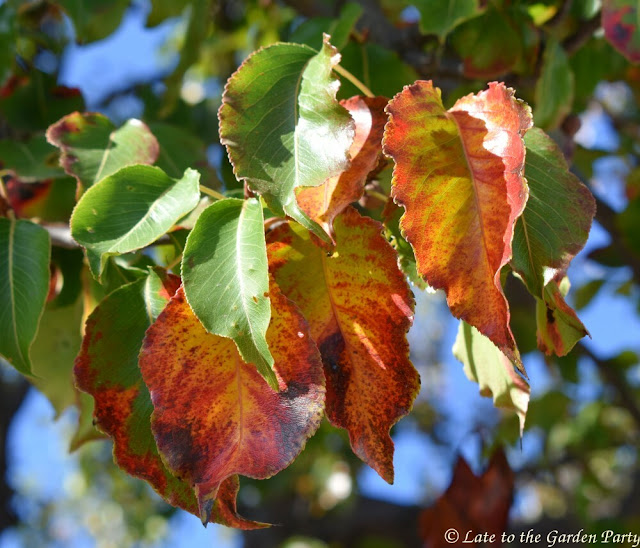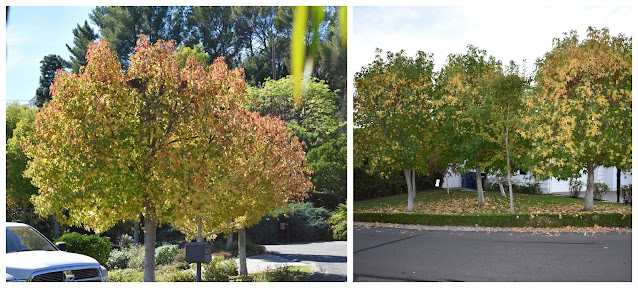Temperatures have gone up and down this fall but, despite periodic blasts of summer-like heat, we have some touches of fall foliage color. It's nothing like what the northeastern part of the country has to offer but we appreciate what we get nonetheless. Evergreen plants are more common in my climate than deciduous ones but we also don't get cold enough to allow the deciduous plants we do have to color up. Freezes are a freak occurrence here - I haven't experienced one in the 10+ years we've been in our current home. Just for fun, I ran an online search to see if I could find evidence of any freezes in my general area in the recent past. I found an article (complete with photos) pointing to snowfall in 1949, which you can find here.
 |
| Acer palmatum 'Sango Kaku' reliably delivers fall color. In contrast, my dwarf Japanese maple 'Mikawa Yatsubusa' (not shown) goes from green to a gray brown. I was shocked when I saw a photo of the red color it delivers in other situations. |
 |
| Cotinus coggygria 'Royal Purple' colored up rather well this year, although I need to do a better job of pruning it to encourage it to develop a bushier shape |
 |
| This persimmon tree, Diospyros kaki 'Fuyu', also puts on a good display |
 |
| However, the 'Hachiya' persimmon, just feet away, develops very little color before all the leaves drop |
 |
This is the first year in the garden for Ginkgo biloba 'Autumn Gold'. It didn't develop the warm yellow foliage the cultivar is known for, which may be at least partly my fault. It started dropping leaves mid-summer. I increased the water and the leaf drop stopped but perhaps that early stress affected its ability to handle peak summer heat. It's now dropping toasted brown leaves.
|
 |
| The leaves of the ornamental pear, Pyrus calleryana, develop vivid color before they fall but this happens so gradually the tree itself never looks as stunning as it does in colder climates. Many of the leaves hang on and remain green until spring when the tree begins to flower and new leaves develop. |
 |
| Oddly, some but not all of the star jasmine, Trachelospermum jasminoides, develop red foliage |
 |
| This potted blueberry, Vaccinium x 'Sunshine Blue', turns redder than the 'Bountiful Blue' varieties sitting alongside it |
The neighbors across the street get more color than we do but their trees are off to a late start this year.
 |
| Most of these are maples of some kind but there are a couple of Ginkgos in the mix, one of which is still mostly green |
I may have little in the way of the golden yellows, oranges and reds that signal fall for most people but many of the drought tolerant plants in my garden glow in a different way. I'll close by offering a few examples.
 |
| Agave 'Blue Glow' surrounded by Aeonium 'Sunburst', Euphorbia rigida, and Dasylirion longissimum |
 |
| My oldest Agave ovatifolia, planted in 2012 |
 |
| Celadon green Agave ovatifolia 'Vanzie', planted in 2015 (shown from two angles) |
 |
| My favorite Echium, E. webbii, with its silvery leaves |
Enjoy a colorful weekend!
All material © 2012-2021 by Kris Peterson for Late to the Garden Party













The blue and silver is just as delightful.
ReplyDeleteI think so too, Diana, but then I love blue foliage and flowers wherever and whenever I find them.
DeleteYou do get a surprising amount of coloring of leaves, Kris. The Japanese maple is so lovely, and as always, Agave 'Blue Glow' is wonderful.
ReplyDeleteI wish I had better luck with Japanese maples here, Eliza. They need protection from intense sun and wind here to survive so there are any so many viable spots to plant them.
DeleteI don't see many Sango Kaku's in Southern California looking as happy as yours. Beautiful!
ReplyDeleteFrom what I remember from my nursery days, Trachleospermum asiaticum (cousin to T.jasminoides) is the one that will turn reddish bronze in the fall. It's less common to find in nurseries - not as floriferous and more restrained in its growth compared to star jasmine. You see it more often as a ground cover or in pots than climibing. It comes in variegated versions as well.
Thanks for that plant ID, Steph! I inherited all the Trachelospermum here with the garden so my ID was pure conjecture. I'm glad to have an explanation for why only some of these plants color up each fall.
DeleteYour Ginkgo I'm sure will develop better fall color in the future. Those crispy leafs are probably just the stress of being newly planted. The color hues in picture 10 ('Blue Glow', Aeonium 'Sunburst', Euphorbia rigida, Dasylirion) surpasses, at least in my mind, any fall color you may be missing out there in southern California.
ReplyDeleteFingers crossed that your assessment of the Ginkgo proves true!
DeleteThe great thing about succulents is they usually look good year round. I only had a small number in my former garden but now can't imagine a garden without them.
Beautiful foliage! I don't think of SoCal as having fall color, but you've shown that it happens there, too. Stunning photos. Have a very Happy Thanksgiving!
ReplyDeleteFew people design for fall color here because it is unusual, Beth. I hope you enjoy a wonderful Thanksgiving too!
DeleteLovely Acer there. Mine got a bit of color--speculating that happened because we didn't get a big early Santa Ana to strip everything before an extended period of coolish nights. A couple Ginkgos in the neighborhood have colored up nicely. Your new baby looks really, really good. Here they all develop a southwestern tilt due to the northeast Santa Anas.
ReplyDeleteThat 'Sango Kaku' has done exceptionally well cozied up against the garage, HB. I planted a second one in spring behind our front hedge. It didn't handle summer nearly as well but I'm hoping that'll improve as it gets older. The Ginkgo was planted with a support in place, which has helped it stand up to the Santa Anas as it gets established.
DeleteWhile traditional Fall colour is somewhat absent in your climate there are a ton of plants showing gorgeous colour and flowers. While I really love Fall colour here it is fleeting so love to enjoy yours vicarously.
ReplyDeleteWhat little fall color we do get tends to stretch itself out from late October through December. The neighbor's maples should shine next month, although late heatwaves can have a negative impact. The heat is back on again now :(
DeleteDavis isn't exactly known for fall color either, but this year it seems better than in previous year. Maybe the 5" of rain a month ago?
ReplyDeleteBut who needs fall color when you have agaves like yours!
Five inches of rain sounds SO good to me right now - we're sitting at just over half an inch since October 1st. To the extent that rain helps leaves hang on, it may make some difference but I think it comes down to how cold the nights are here.
DeleteI know we gardeners tend to long for what we can't easily have, but I prefer your agave version of fall's glow...
ReplyDeleteHaving a bit of both is the way to go, Loree ;)
Delete